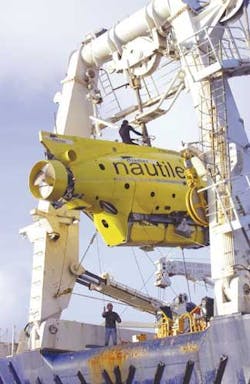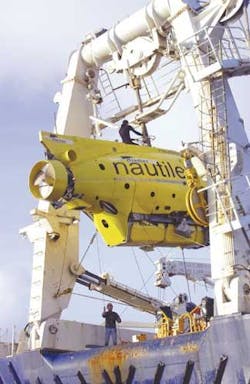GEP leading initiatives for French, European suppliers in USA, Russia
Jeremy Beckman
Editor, Europe
Although this year's France pavilion at the Offshore Technology Conference in Houston will have fewer exhibitors than before, due to recent mergers, organizer GEP is gaining in influence. This follows its recent award of a contract from the European Commission, under the latter's 6th Framework Program, to promote European technologies around the world.
According to GEP consultant Claude Bouty, responsible for this contract, "The EC is providing finance for four exhibitions: OTC this year and next year, Offshore Europe in Aberdeen in September, and ONS Stavanger in August 2004. Under our contract, we will provide free booth space and logistics for innovative European small equipment manufacturers (SMEs) participating at certain shows under the EC's banner. The exhibitors will have to pay their own travel, accommodation, and freight costs up front, but they will be eligible for some compensation for these afterwards."
In fact, this is a joint contract also involving GEP's counterpart supplier organizations IRO in The Netherlands and Decon in Germany, although GEP is the overall coordinator. For the current OTC, IRO will act as manager of the 140-sq-m EC pavilion (with participation from at least three French exhibitors), but GEP will assume the lead role at Offshore Europe and OTC 2004.
"Also," Bouty says, "GEP is managing five seminars or workshops staged in Russia, with the assistance of our subcontractor ERIP, a body promoting links between the petroleum industries in Europe, Russia, and Siberia." The first of these, held in March, focused on advanced seismic technologies to aid reservoir management. These workshops are part of the EC's strategy to further exchange of technologies between Russia and Europe.
As new GEP Managing Director Didier Treu-ssier points out, Russia should be a land (as well as sea) of new opportunities for the French oil and gas sector. To prosper in this market, the French contractors will need to form partnerships with Russian companies, irrespective of the operating intentions of Total. (Close relations with this French major have paid off in recent years with numerous contracts for French suppliers in emerging regions such as Angola and Iran.)
Recently, Total has extended its focus to Brazil's Campos basin, where it is understood to be drilling a well in around 2,500 m of water using drillship S10000. But according to Treussier, prospects for French suppliers in this region will depend on the attitude of Brazil's new government and its relationship with Petrobras. Technip-Coflexip remains the only company to have established a reputation in Brazil as a pipelay contractor and flexibles manufacturer.
GEP was invited to make presentations to Venezuela's government, following a meeting with President Hugo Chavez at last year's World Petroleum Congress in Rio. In Treussier's view, however, the real thrust for the French should be Mexico. "This country is very keen on having non-US service providers. But this process takes time. We need to get to know the Mexican contractors. At a recent meeting with Pemex managers, they told us they wanted to go deeper in the Gulf of Mexico, and they were attracted by our capacity in deep offshore technology."
Recently, companies such as Technip and Bouygues Offshore (now owned by Saipem) have been successful in forming offshore fabrication partnerships in the Azeri and Kazakh sectors of the Caspian. "But generally, our companies are busy with the established markets," Treussier says, "so there is some reluctance to invest heavily in new areas. If our main service companies and contractors are to develop greater local content, they must pay more attention to internationalizing their workforce, particularly with regard to engineers. Schlumberger, at least, has been doing this successfully for years."
According to Victor Vachier, the former executive vice-president of GEP who is still retained as a consultant, the French pavilion at the major offshore events is increasingly attracting SMEs, and this is a trend that needs to be fostered.
"In France, we still have a very significant share of the offshore services market," Vachier says. "We want to make more French SMEs aware of this market and to increase their share of it. All the figures show there is still a lot of oil that needs to be developed, and the recovery rate has to be raised. This should provide a big market for our service companies and suppliers."
The French are establishing an edge in deepwater robotics, through ROV/AUV manufacturers ECA and Cybernetix. The latter won GEP's recent innovation award for its Swimmer AUV.
The state-owned institution Ifremer has developed deepwater research vehicles and was involved in studies to stem leaks from the sunken oil tanker Prestige. There are specialist schools in the Marseille area for robotics and testing of ROVs, and the Ecole des Mines in Cannes has participated in tests in deepwater energy sources for autonomous vehicles. These technologies will be highlighted at this year's Deep Offshore Technology Conference in Marseille in November.
A recent demonstration of French deepwater engin-eering expertise was Ifremer's "salvage" operation on the sunken tanker Prestige, off northwest Spain. The program involved use of Ifremer's surface vessel l'Atalante and its semisubmersible Nautile (launched from the l'Atalante). Sounder and sonar equipment on the two vessels was used to locate the front and rear sections of the wreck, which had split and come to rest 3.5 km apart on the seabed, in respective depths of 3,565 m and 3,830 m. A 3D map of the local seabed cart-ography was also compiled. The Nautile's tele-operated robot Robin was then deployed around the wreckage to assess damage to the tanks in particular and the extent of the leaks. Repair operations were mounted, which successfully stemmed the outflow of crude. Altogether, 36 dives were undertaken by the Nautile for this project between December 2 and February 13.
null

